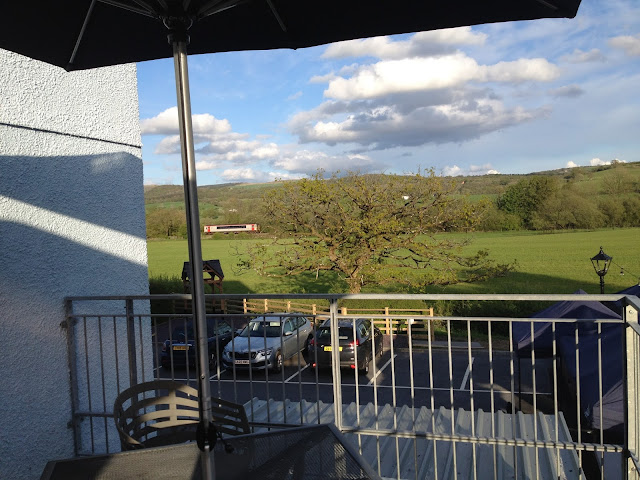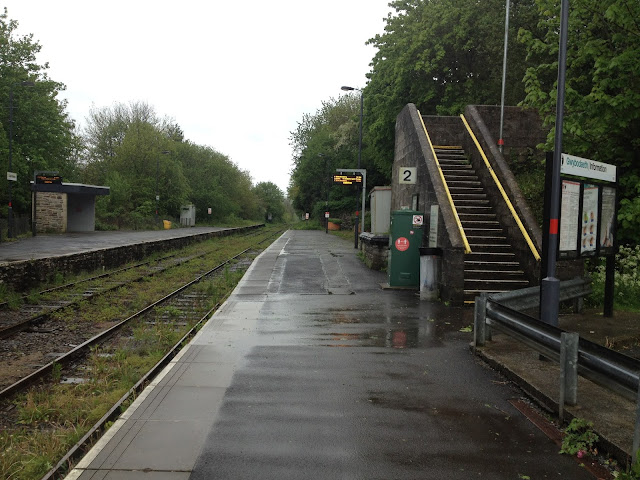Doncaster Robert’s Road’s Class 66 No. 66785 was at the head of the Immingham to Mantle Lane freight on Friday 28th May. Its seen here passing through Fiskerton station mid-morning. As the Class 60s dominate the oil traffic on this route, the 66 “sheds” offer a bit of variety, though many of the assigned freight movements have not been activated in recent times and daytime passenger services also remain relatively sparsely occupied.
Monday, 31 May 2021
Friday, 28 May 2021
Action on the High Marnham Test Track
A Plasser and Theurer whotsit passes slowly over Cocking Hill between Ollerton and Laxton on the afternoon of 27/5/21. It was a very long train of yellow machinery. I’m plumping for a Network Rail ballast cleaner, but I stand to be corrected. There’s only so much time I’m prepared to give to this one. One thing’s for sure. At the trailing end of the formation was PW-RT Materials Handling Train Power Wagon No. DR 92431. Pictures with thanks to Chris Priestley.
Wednesday, 26 May 2021
A Tale of Two Junctions
Meeting up with friends, Ian and Sandra, for the first time after lock-down, involved plotting a location roughly midway between us with a decent weather forecast for the day and the prospect of a spacious and welcoming cafe. This led to an intriguing little corner of the country that was quite new to us, but as is so often the case when exploring hitherto unseen pockets of Britain, it turned out to be a real gem.
Great Haywood in Staffordshire was our base for the day -
more specifically, it was the Canalside Café, where we were very well received.
All the necessary precautions of the age we now live in were provided. The premises
are modern, light and airy, the service is excellent, the food is good quality and
provided in substantial quantities.
The village lies at the junction of the Trent and Mersey and
Staffordshire and Worcestershire Canals. Canal-side walks also take in the
River Trent, itself, the existence of which made this lowland corridor such an
attraction for communications in the first place. The direct rail route from
Manchester to London via Stoke provides the back-drop on an embankment to the east,
meeting the West Coast Main Line proper just to the south at Colwich Junction.
The WCML from Stafford has just negotiated Shugborough tunnel at this point and a short walk west from the canal tow path takes you into the grounds of Shugborough Hall, now open again as a National Trust attraction, including its herd of distinctive English longhorn cattle. From the bridge facing the south portal of the tunnel, we were in time to see Class 66 No. 66192 at the head of the Ashburys to Montsorrel empty mineral wagons, followed shortly by an Avanti Liverpool to Euston express in the form of Class 390 Pendolino No. 390006.
Photo with thanks to Ian Hughes
Sunday, 23 May 2021
The Clan Class
There were just ten members of the Clan Class. The 4-6-2s were designed by Robert Riddles for BR in 1952 and built at Crewe works. A further fifteen were planned but never constructed. At 6P5F, they were lighter and less powerful than the Britannias, and for me the front-end view of the locomotives was not quite so pleasing as that of their distinctive predecessors, probably due to the use of a smaller boiler. I saw all of the class but my abiding memory is of No. 72000 Clan Buchanan at the head of a Glasgow-bound train in Liverpool Exchange station, c. 1960. The Liverpool and Manchester sections of the Glasgow expresses were combined northbound and divided southbound at Preston, I think, so the main train engine probably took the Manchester component. In the years that followed I can’t remember ever seeing any of the class working south of Preston again. None of the Clans were preserved, but the construction of No. 72010 Hengist is well under way. John Dyer photographed No. 72001 Clan Cameron at Preston in the summer of 1959 and No. 72004 Clan MacDonald at Glasgow Central on 3/8/60.
Saturday, 22 May 2021
Llandeilo, Carmarthenshire – a very welcome short break away from home
The Shrewsbury to Swansea Heart of Wales Line is a rural railway that somehow survived the Beeching axe [possibly because it ran through 6 marginal constituencies]. It is now operated by Transport for Wales. It is mainly single track with relatively few passing loops and the few daily trains in each direction are operated using Class 153, Super Sprinter railcars.
The evening train to Shrewsbury is threading its way up the Towy valley towards Llandovery, as seen from the excellent outdoor dining facility at the Plough Inn on the edge of Llandeilo, on 17/5/21.
The attractive Pantyffynon station building, pictured on 18/5/21, is located next to the level crossing on the minor road south from Ammanford. This was the junction for the branch to Gwaun-Cwm-Gurwen and it formerly served the collieries in the Amman Valley.
Class 153 No. 153329 forms the afternoon train for Shrewsbury, on 19/5/21. It has just left Landebie for Landeilo and is seen passing under the minor road bridge at Derwydd.
Llandeilo station is receiving a soaking on 21/5/21, helping the vegetation to grow on the track bed. This was formerly a junction with the long-closed line to Carmarthen and it retains a passing loop and a second platform.
Saturday, 15 May 2021
Cambois
I have to admit that although I’d heard of Cambois, I did not know where it was. I should have done because I’d been there, or very close to it, 55 years ago and on the morning of 26th February 1966, to be precise. Cambois is just north of Blyth. Brian and I had got there to kick off a shed bash that included North Blyth and South Blyth [by taking the little ferry between the two] then Gateshead and Tyne Dock. From memory, we took the metro and the bus and made full use of Aidan Fuller’s shed directory but mostly, I think, that we walked a lot.
After the closure of the steam sheds at Blyth a purpose-built diesel depot was constructed to replace them. It, itself, closed in 1994 after a quarter of a century of operation, hence the nameplate now carried by Class 66 No. 66778 Cambois Depot 25 Years. Yesterday, this loco’ was at the head of the Immingham to Mantle Lane "metals" that was through Rolleston, mid-morning.
Tuesday, 11 May 2021
Rule Britannias
For a long time, or so it seemed, there were certain Brits that were beyond reach for us LM spotters. East Anglia appeared to be a world away. Stratford, Norwich Thorpe and March remained as just names on a map. Eventually, of course, we didn’t have to go and search out these intriguing namers that we needed to complete the set, because Hereward the Wake, Coeur-de-Lion, Alfred the Great, etc, came to us, instead.
The 55-strong Britannia Class Pacifics were designed by
Robert Riddles for British Railways and introduced in 1951. They were
classified as 7P6F. They were well-proportioned and impressive locomotives, although
they only enjoyed relatively short lives, lasting until the end of steam in
1968. Two members of the class, Nos. 70000 Britannia and 70013 Oliver Cromwell
have been preserved.
I saw all the BrIts and most of them many times. Some
examples were so commonplace within our sphere of movement that we ridiculed
their frequent re-appearances from the platform ends, even renaming Flying
Dutchman as Flying Dustbin, and probably rewarding its seemingly inevitable
return with a volley of abuse, for good measure.
John Dyer photographed the Brits fairly regularly and included here are shots of Nos. 70000 Britannia at Wigan North Western, 70023 Venus at Saltney, 70024 Vulcan at Chester General [all on 26/8/65], 70028 Royal Star at Preston on 15/7/64, 70039 Sir Christopher Wren at Chester in August 1965 and 70046 Anzac at Chester, again, this time in July 1964.
Sunday, 9 May 2021
LNER Class N15
These Class 3MT 0-6-2 tanks were designed by Reid for the North British Railway as an adaptation of the earlier N14 and introduced in 1910. I did not get round to seeing any of these engines and they were all withdrawn by 1962, with none being preserved. John Dyer found his examples on a trip to Edinburgh on 30/7/60. No. 69150 was bringing a freight train into Edinburgh Waverley and No. 69173 was on St Margaret’s sheds.
Thursday, 6 May 2021
LNER Class J50
These side tank shunting locomotives were a Gresley design for the Great Northern Railway, introduced in 1922 as rebuilds of earlier 0-6-0 engines. 102 were built in total, at Doncaster and Gorton works. All were scrapped by 1965 with none being preserved. John Dyer photographed 3 members of the class - No. 68908 at Low Moor MPD on 12/8/62, No. 68986 double-heading through Doncaster station on 30/4/62 and No. 68991 on station pilot duties at London King’s Cross in August 1959.
Monday, 3 May 2021
LNER Class J72
Introduced in 1898 and designed by Worsdell as Class E1 for the North Eastern Railway, these 0-6-0 tanks were later classified as 2F under BR. Employed as shunters and station pilots, 113 were eventually built at Darlington works, Doncaster works and by Armstrong Whitworth over an extended period between 1898 and 1951. No. 69023 Joem is the only steam locomotive I have ever driven, during a footplate experience at Shildon in 2009. This was a much-appreciated big birthday present from some very generous work colleagues. John Dyer photographed No. 68722 at York station in 1956 and No. 68736, also at York, on 26/7/60.

































